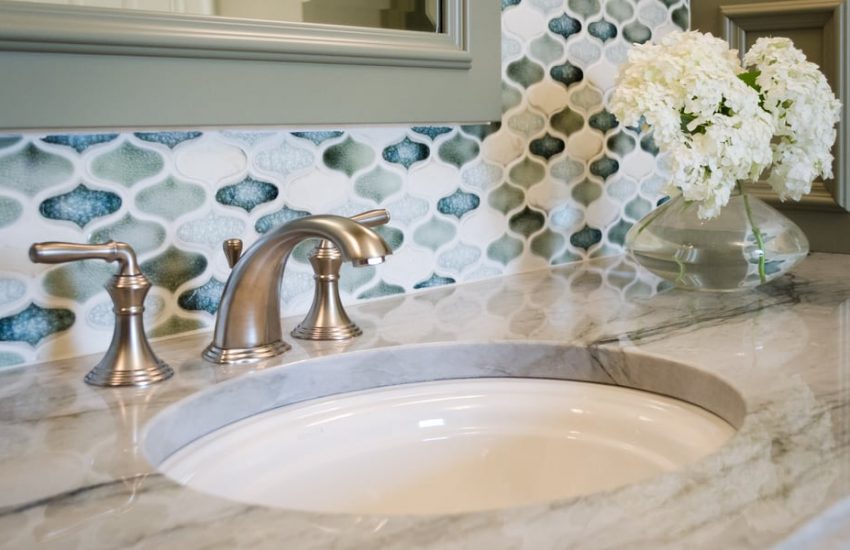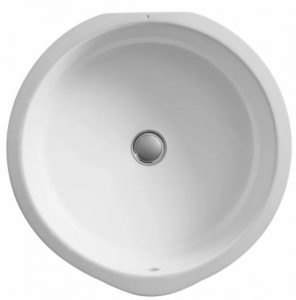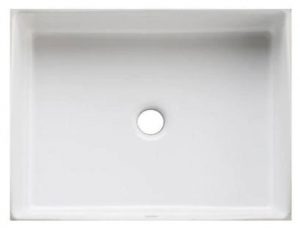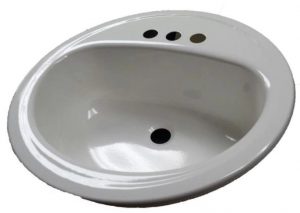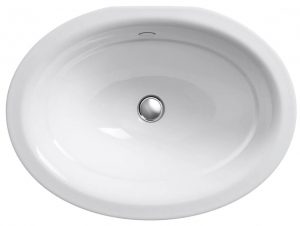Choosing a Bathroom Sink
When choosing a bathroom sink, the first thing you need to know is what is available. Simply typing “best bathroom sink” in Google returns 227 million results! Typing “choosing a bathroom sink” returns almost 15 million results! Every retailer, manufacturer, specialty, and internet store will tell you they have the answer. The answer is always the one that yields the highest profit!
There are only 5 questions to answer when choosing a bathroom sink. These are:
- Type
- Style
- Material
- Size
- Color
When choosing a bathroom sink, there are basically 4 types of residential sinks.
- Undermount
- Drop-In
- Vessel
- Pedestal
|
|
|
|
Undermount Sink
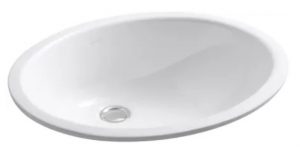 When choosing a bathroom sink, these sinks are preferred by a wide margin. Why? Firstly, they do not show dirt and grim around the rim and make cleaning the countertop easy. Unlike their drop in cousin, there is no rim above the counter to catch unsightly dirt and stains. Secondly, unlike a drop-in sink, there are no limitations to faucet selection because of the pre-drilled and placement of the faucet holes. Third, drop-in sinks are susceptible to buildup of lime, calcium, and debris around the faucet. This is especially true when the sink is white or a lighter color. Lastly, undermount sinks are far less likely to chip and brake because there is no exposed rim.
When choosing a bathroom sink, these sinks are preferred by a wide margin. Why? Firstly, they do not show dirt and grim around the rim and make cleaning the countertop easy. Unlike their drop in cousin, there is no rim above the counter to catch unsightly dirt and stains. Secondly, unlike a drop-in sink, there are no limitations to faucet selection because of the pre-drilled and placement of the faucet holes. Third, drop-in sinks are susceptible to buildup of lime, calcium, and debris around the faucet. This is especially true when the sink is white or a lighter color. Lastly, undermount sinks are far less likely to chip and brake because there is no exposed rim.
The better quality undermount sinks are made of glazed vitreous china (aka porcelain). Cheaper undermount sinks are made of steel with a glazed porcelain finish on the inside of the bowl. The underside is unfinished. A steel sink is very susceptible to chipping and scratching. The unfinished underside also rusts and begins deteriorating within a few years. Rust also typically first appears around the drain trim.
Undermount sinks are attractive and easy-to-clean. They combine the sleek look of an integrated basin with a timeless design that suits both traditional and modern bathroom decors. These sinks create a sleek transition from the smooth basin to just about any solid-surface countertop. Undermount sinks increase counterspace and have a higher resale value.
Drop-in Sink
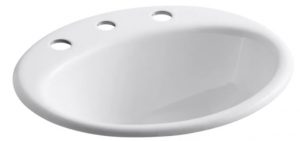 These are typically cheaper than an undermount sink – but not by much. The difference will likely only be about $5-$10 when comparing the same size, style, and material. So why consider a drop-in when choosing a bathroom sink? Undermount sinks typically are recommended for all solid countertop materials except laminate and tile countertops. The laminate is not the issue; it’s the underlying base of particleboard or Medium Density Fiberboard (MDF – aka sawdust and glue). MDF does not hold clip fasteners well, and it is highly vulnerable to moisture damage. The seal between the sink and the laminate must be flawless to keep water away from the MDF (realistically not possible). For more on the differences in cabinet building materials, see Particle Board vs Plywood Cabinets.
These are typically cheaper than an undermount sink – but not by much. The difference will likely only be about $5-$10 when comparing the same size, style, and material. So why consider a drop-in when choosing a bathroom sink? Undermount sinks typically are recommended for all solid countertop materials except laminate and tile countertops. The laminate is not the issue; it’s the underlying base of particleboard or Medium Density Fiberboard (MDF – aka sawdust and glue). MDF does not hold clip fasteners well, and it is highly vulnerable to moisture damage. The seal between the sink and the laminate must be flawless to keep water away from the MDF (realistically not possible). For more on the differences in cabinet building materials, see Particle Board vs Plywood Cabinets.
Typically, cabinets made using MDF and Melamine will use a drop-in sink. The same is true for tile and laminate countertops. Granite and quartz countertops will typically use an undermount sink. For more on the differences between granite and quartz countertops, see What is Better Granite or Quartz?
Drop-in sinks can be installed on all types of countertop materials, not just solid surfaces like granite and quartz. This includes laminate, tile, solid surface, and all composite and natural stone.
Vessel Sink
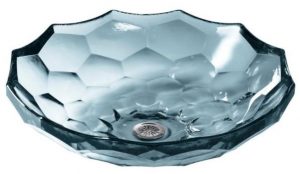 Typically, the most expensive by a very wide margin. The difference is measured in hundreds to thousands of dollars. Vessel sinks along with their faucets are more expensive to install. Faucets used with vessel sinks are also more expensive to purchase and install. Many vessel sink faucets must be installed on the backsplash wall.
Typically, the most expensive by a very wide margin. The difference is measured in hundreds to thousands of dollars. Vessel sinks along with their faucets are more expensive to install. Faucets used with vessel sinks are also more expensive to purchase and install. Many vessel sink faucets must be installed on the backsplash wall.
These sinks require more countertop space and typically a 24-inch depth cabinet. They sit on top of the counter. There are some vessel sinks that sit half below and half above the counter. Vessel sinks are easier to damage. Why? The connection to the countertop is shared with the drain. Unlike undermount and drop-in sinks, in comparison, the bowel is secured by very little.
When choosing a bathroom sink, vessel sinks represent elegance and artisan. This is especially true for glass, fireclay, natural stone, and handcrafted ceramics. The uniqueness and beauty of these sinks are the inspiration for installing. These sinks are statement pieces.
If you have small children or heavily use your bathroom, this is not the sink for you.
Pedestal Sink
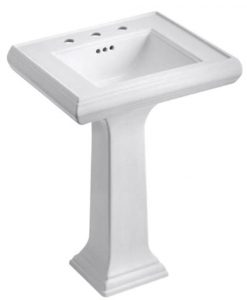 This is the workhorse sink for powder rooms. Most powder rooms are small. Including a traditional sink with a cabinet quickly makes the powder room look cumbersome and encroached. Pedestal sinks are perfect for powder rooms.
This is the workhorse sink for powder rooms. Most powder rooms are small. Including a traditional sink with a cabinet quickly makes the powder room look cumbersome and encroached. Pedestal sinks are perfect for powder rooms.
Less typical for a pedestal sink is the master bathroom. Clients who replace their master bathroom cabinet with one or two pedestal sinks quickly learn of the limitations. Unlike a powder room, the master bathroom is a “well used” and high traffic bathroom. Toilet paper, personal hygiene products, personal care products, makeup, and grooming appliances all need space. This is especially true when shared by two people! If the cabinet is removed for pedestal sinks, where does all this stuff get stored?
What about counterspace for all the above items? There is none! Pedestal sinks are design for limited space areas – such as powder rooms. These sinks also add a touch of economic elegance. Two of the most popular are the Kohler Devonshire and Kohler Memoirs.
When choosing a bathroom sink, consider what style works best for you.
The easiest way to think about style is round, oval, and square/rectangle.
|
|
|
It’s a bit difficult to offer advice on style. Honestly, it is a personal preference. What I can tell you is the oval sink is preferred by more than 2:1. A distant second is the square/rectangle sink. I can’t remember the last time a client installed a round sink.
Choosing a sink material.
For residential sinks, there lots of choices. Some, such a stone, are very custom. Most folks don’t spend $3,000+ on a bathroom sink! I will stick to the four most common residential materials. These are:
- Vitreous china (aka porcelain)
- Steel
- Cast Iron
- Glass
|
|
|
|
Some of the least common bathroom sinks are stone, marble, lava stone, fireclay, stainless steel, and cast bronze.
The vitreous china sink is installed more than any other bathroom sink when remodeling. Why? It’s relatively inexpensive, extremely durable, and it looks beautiful. The Kohler Caxton oval 17″ x 14″ vitreous china undermount bathroom sink with over-flow retails for about $108.
Steel is common in tract homes and low-end remodels. Steel sinks rust and chip easily. A steel 19-inch sink is only about $37 retail.
Cast iron is the most durable. The Kohler Serif oval 18” x 13” cast iron undermount sink is about $230 retail. It has a lifetime warranty.
Glass is the most elegant and expensive. The Kohler Briolette vessel glass bathroom sink retails for about $930.
Size when choosing a bathroom sink.
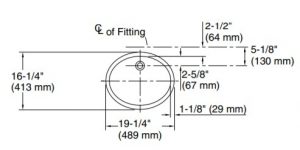 Size matters when choosing a bathroom sink. Most tract grade (cabinets your home came with from the builder), and store-bought cabinets are 21 inches deep. This limits your sink selection. When I remodel a bathroom, most clients want a bigger, deeper sink. They also want to add some style to their sink. This typically requires a 24-inch-deep cabinet. Vessel sinks absolutely require a 24-inch-deep cabinet.
Size matters when choosing a bathroom sink. Most tract grade (cabinets your home came with from the builder), and store-bought cabinets are 21 inches deep. This limits your sink selection. When I remodel a bathroom, most clients want a bigger, deeper sink. They also want to add some style to their sink. This typically requires a 24-inch-deep cabinet. Vessel sinks absolutely require a 24-inch-deep cabinet.
When choosing a bathroom sink, the backsplash, faucet, and how the cabinet is constructed must also be considered. A 21-inch-deep cabinet with a 1-inch edge detail/overhang along with a 1-inch-thick backsplash makes for a small sink! You are usually limited to a round sink with this situation. Adding in the faucet really narrows your choices. If you purchased a big box, internet, or RTA cabinet, your choices are limited even further.
Ever notice that almost all manufactured cabinets include the countertop, splash, and bowl? That’s because finding a sink that will work with a 21-inch cabinet would be very difficult. The manufactures have countertops and bowls made special to fit their cabinets construction and limited space. They also pre-drill the faucet holes. Unless you install a custom-made cabinet, you will have very limited selection for a sink (and possibly the faucet). If you damage one of these pre-installed bowls, finding the correct replacement is very difficult if even possible.
Color when choosing a bathroom sink.
![]() I think it is safe to say white knocks it out of the ballpark! Why? White goes with everything and it never goes out of style. Many clients can still remember the green, pink, blue, and yellow sinks of the 1950s era. Designers, try that they may, keep trying to bring this era back. Clients continue to say “NO!”. White wins decade after decade.
I think it is safe to say white knocks it out of the ballpark! Why? White goes with everything and it never goes out of style. Many clients can still remember the green, pink, blue, and yellow sinks of the 1950s era. Designers, try that they may, keep trying to bring this era back. Clients continue to say “NO!”. White wins decade after decade.
If you want a color sink, that’s fine – its your house! However, it is a very personal thing and does reduce the resale value of your bathroom. Since most folks will only remodel a bathroom once in 30-40 years, that’s a long time to live with a pink sink! However, it’s usually not just the sink that has color. The sink, toilet and tub usually match.
White will be in style today and 50 years from now. It compliments all other colors and textures and is neutral. You will never go wrong with a white sink.
How Can I Receive More Information?
If you would like more information on enjoying the best bathroom, kitchen, and interior remodeling experience in Orange County, call Dan at (949) 380-0177 or at dan@dadsconstruction.com for a free in home consultation. DAD’s serves all of South Orange County California. This includes Lake Forest, Mission Viejo, Foothill Ranch, Portola Hills, Ladera Ranch, Irvine, San Clemente, Dana Point, San Juan Capistrano, Rancho Santa Margarita, Coto de Caza, Dove Canyon, Laguna Niguel, Laguna Hills, Newport Beach, and Aliso Viejo.
“Taking Care of Your Home . . . The Way We Would Our Own”
Daniel A. Derkum is the owner of DAD’s Construction. DAD’s is a leading South Orange County, California design-and-build remodeling and renovation Contractor. See https://www.dadsconstruction.com. © DAD’s Home Services & Construction, Inc. All Rights Reserved.
